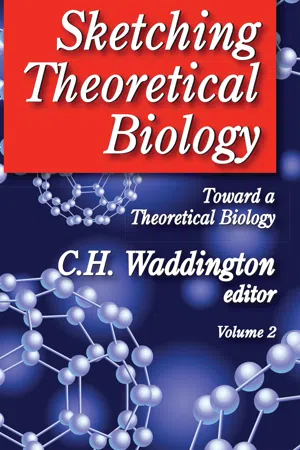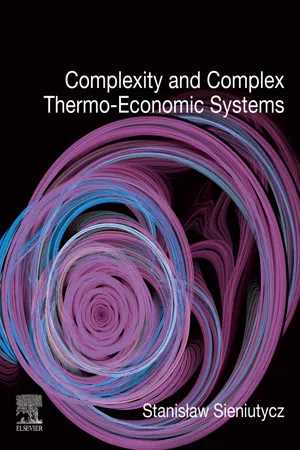Physics
Hierarchical Structure
In physics, a hierarchical structure refers to a system organized in levels, with each level having a specific role or function. This arrangement allows for the categorization and understanding of complex systems, such as in the study of particle physics or cosmology. Hierarchical structures help physicists analyze and model the behavior of various phenomena at different scales.
Written by Perlego with AI-assistance
Related key terms
Related key terms
1 of 4
Related key terms
1 of 3
3 Key excerpts on "Hierarchical Structure"
- eBook - ePub
- Errol E Harris(Author)
- 2014(Publication Date)
- Routledge(Publisher)
At each level in the scale the distinguishable entities are discriminated by their characteristic form or structure, and at each succeeding level this form is more coherent and complete than at the previous level. Each advance implies fuller reflection of and closer approximation to the independence and self-sufficiency of the whole in each of the entities characteristic of that level. It seems that the principles of order and wholeness immanent in the world are expressed and exemplified more adequately at each succeeding stage. This does not, of course, imply any simple, superficial resemblance between whole and part. The physical universe is not an immense solar system, but a scattering multitude of galaxies, which bears no immediate resemblance to atomic or molecular structure. Its coherence lies rather in the laws of nature that govern the relations between and the behaviour of its parts and bind it into a single, self-contained continuum. These principles of integration are manifested in the parts in progressively more adequate degrees. Elementary particles conform to natural laws, but for the most part as subject to their imposition from without. They display no very marked internal efflorescence of diversified coherence. The atom, on the other hand, contains within itself a complex system of relations regulated by laws of nuclear, electrical and magnetic forces, of quantum mechanics and of gravitation, and ordered throughout by the operation of the exclusion principle. All of these have been shown to be logically interconnected; so that the atom in itself is a system with a high degree of stability, exemplifying and expressing to a greater extent than members of the lower grades in the physical hierarchy, the principles of organization immanent in the world as a whole. Moreover, it is less dependent than lower forms upon external influences for its construction and persistence, and so is a closer approximation to the inclusive self-sufficiency of the physical universe. Molecules, though they may be more complicated and heterogeneous in content, are not always so stable and cohesive, and it may be necessary to proceed beyond the inorganic level to reach what is genuinely the next stage in the hierarchy.It is clear that each physical form belonging to the hierarchical array is a specific variation of the substrate activity that in undifferentiated form is simple mass-energy. The photon of radiant energy, the electron, the positron, the neutrino, the meson, the neutron and the proton, are all species of a single genus, and, as Heisenberg prognosticates, may be eigensolutions of a single equation. Yet even these seem to range themselves in ascending order of complexity and stability. Again, elementary particle, atom, molecule, are specific differentiations of material particle, though now more obviously graded as combinations (though never simple aggregates). But these specifications of a single general form bear to one another yet another type of relationship not without logical significance, though it does not appear to be regularly correlated with their order in the scale. There is between them an element of opposition and contrast. Energy is active and flowing; matter is, by comparison, stable and inert. Elementary particles are opposed in charge and have opposite spin. Molecules may be homopolar or heteropolar. At this stage we can but note these oppositions, their precise importance not being clear. Later thay may fall into place in a more general scheme of systematiza-tion. - eBook - ePub
Sketching Theoretical Biology
Toward a Theoretical Biology, Volume 2
- Wilhelmina A. Leigh(Author)
- 2017(Publication Date)
- Routledge(Publisher)
At the 1967 meeting at Bellagio the idea of a hierarchy frequently entered the discussions. This was to be expected. If one thinks at all about biological systems, it is natural to simplify the problem of getting a comprehensible picture of what is going on in them, by drawing boundaries around blocks of activities which have a fairly obvious coherence and autonomy; and having one such block exercise control over others, while being controlled by yet another or others. When we have done this, we have already imposed the concept of a hierarchy. Sometimes it is clear that the imposition of Hierarchical Structure is natural, because the ‘blocks’ are very apparent in their action. Other times it is extremely hard to find them at all, yet the hierarchical idea has such a grip on us that we still find biological systems of this second kind being thought of in terms of these blocks. This latter situation is particularly common in theories of brain physiology.My task in this note is to think of Hierarchical Structure as abstractly as possible, in order to get a simple picture of the logical and mathematical relations that must exist between the ‘blocks’ if they are to constitute a hierarchy. The picture that I shall put forward will be remote from detailed biological experimentation, but this requires no apology, for, if it is really the case that biologists are in the habit of using hierarchical ideas as a conceptual framework for biological systems, then it is important to be as clear as we can what consequences this habit really imposes on us.To pursue this task I shall use mathematical ideas from a hierarchy theory that was developed by Amson, Bastin, Parker-Rhodes, and Kilmister [1 ] for application to foundational questions in quantum theory, and I go back to the root from which the hierarchy idea sprang-namely the priestly and then political hierarchy-to provide a simple picture to which these mathematical ideas apply. I do not of course claim that this simple picture of a hierarchy formalized in this way is the only one that can be formalized, or even that the formalization in question is the only possible formalization of that picture. It is, however [2 - eBook - ePub
- Stanislaw Sieniutycz(Author)
- 2019(Publication Date)
- Elsevier(Publisher)
Until now, the most popular paradigms used for explaining selforganization (e.g., attractors, synergetics, catastrophes, etc.) are characterized by a mere two-level structure: the “microscopic” level where a multitude of building blocks or elements (e.g., molecules, individual organisms) interact, and the “macroscopic” level where these interactions lead to certain global patterns of organization, e.g., a dissipative structure or a crystalline symmetry. The resulting systems as studied through these paradigms, e.g., an ideal crystal, a trail of ants carrying food back to the nest, or a regular pattern of fluid rolls in the Benard problem (Fig. 2.3), are usually simpler in their structures and treatments than multilevel hierarchical systems. See Schneider and Kay (1995), and Chapter 10 for more details on Benard phenomenon. 2.4.2 Emergence and the complexity Realistically complex systems (e.g., organisms, societies, ecologies), however, are characterized by a multilevel structure. A classic explanation for this hierarchical “architecture” of a complex system was given by Simon (1962). His argument is based on a variation-and-selection of natural and artificial evolution: elements are connected and combined by natural interactions, or equivalently, by the trials of a problem solver, thus creating a variety of assemblies. Of these assemblies, only those will survive which are sufficiently stable. The other assemblies will be all apart before they can undergo any further evolution
Index pages curate the most relevant extracts from our library of academic textbooks. They’ve been created using an in-house natural language model (NLM), each adding context and meaning to key research topics.
Explore more topic indexes
Explore more topic indexes
1 of 6
Explore more topic indexes
1 of 4


